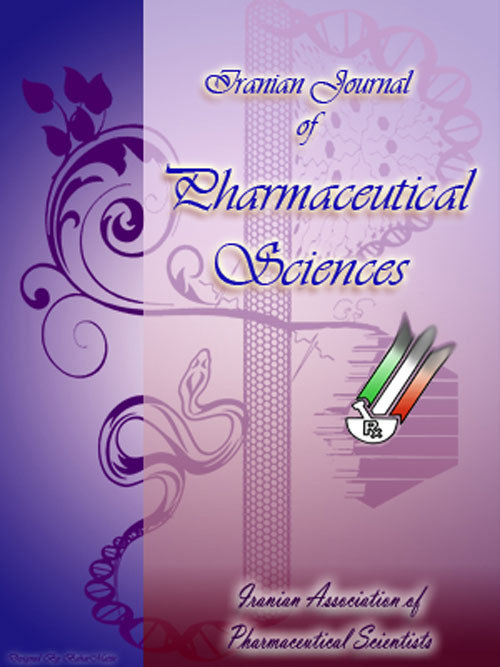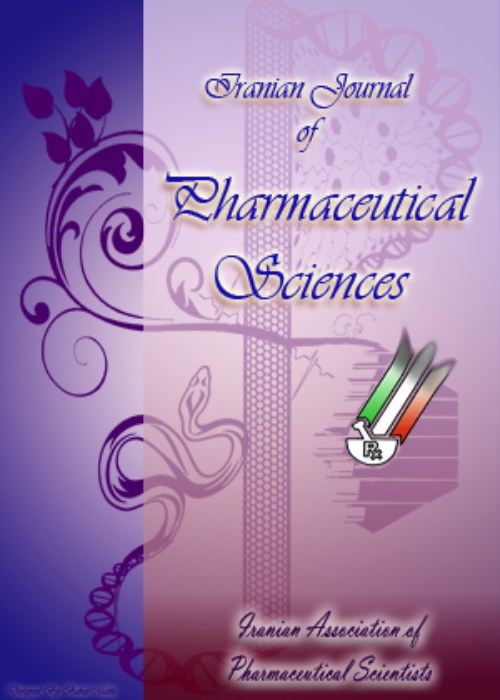فهرست مطالب

Iranian Journal of Pharmaceutical Sciences
Volume:16 Issue: 2, Summer 2020
- تاریخ انتشار: 1399/05/11
- تعداد عناوین: 8
-
-
Pages 1-18Temu mangga (Curcuma mangga Val.) has been widely used to overcome health problems in Indonesia, one of them as the ingredient of Madurese herbal medicine. The active compounds contained in C. mangga extract have potential as a medicine to improve female fertility. This study aims to determine the content of phytochemicals and antifungal and antioxidant activity of C. mangga rhizome extract in some solvents based on their polarity.C. mangga rhizome was extracted by a maceration method using ethanol (polar), chloroform (semi-polar), and n-hexane (non-polar) solvents. Standard phytochemical methods were used for a preliminary phytochemical screening of the plant extracts. Antioxidant activity test was conducted using DPPH method with extract concentrations of 25, 50, 100, 200, and 400 ppm. The antifungal activity test against Candida albicans used the Kirby Bauer method with a 100% concentration and microdilution method with percent concentrations of 50, 25,12.5, 6.25, 3.13, 1.56, 0.78, and 0.39.Phytochemical analysis of the ethanol and n-hexane extracts showed the presence of alkaloids and triterpenoids, while chloroform extracts revealed the present of triterpenoid only. The antioxidant activity test of ethanol extract, chloroform, and n-hexane yielded IC50 values of 99.33 ppm (active), 119.3 ppm (medium), and 192.1 ppm (medium) and the inhibitory zones of C. albicans fungi were 5.172 mm, 1.780 mm, and 3.343 mm, respectively. MIC values of all extracts studied were found at 0.78% concentration and MFC values at 1.56%.Rhizome of C. mangga extracts contain flavonoid, alkaloids, and triterpenoids that have antioxidant properties and antifungal activities against C. albicans. Ethanol is the most promising solvent for extracting the active compound of C. mangga rhizome, which functions as an antioxidant and antifungal, proven to produce a higher antioxidant and antifungal activity than chloroform and n-hexane.Keywords: Antioxidant, Antifungal, C. albicans, C.mangga, Phytochemical, Herbal Medicine
-
Pages 19-26Tuberculosis (TB) is an infectious disease caused by Mycobacterium tuberculosis. The α-mangostin in mangosteen pericarp extract can inhibit M. tuberculosis growth. This study examined the potency of α-mangostin in mangosteen pericarp extract to inhibit 38-kDa and Ag85 protein secretion from M. tuberculosis H37Rv. The samples used in this study were divided into three independent variable groups (3.125 µg/ml; 6.25 µg/ml; and 12.5 µg/ml α-mangostin in the mangosteen pericarp extract), a positive control group (rifampin), a negative control group (M. tuberculosis H37Rv), and the Garcia® group (trademark of the mangosteen peel extract capsule). HPLC-MS/MS detected that the mangosteen pericarp extract contained 5,984.55 µg/g α-mangostin. Sodium dodecyl sulfate-polyacrylamide gel electrophoresis (SDS-PAGE) and dot blot analysis were conducted to analyze the profile and specificity of both proteins. This study revealed that 6.25 µg/ml of mangosteen pericarp extract had the greatest potency for inhibiting 38-kDa protein secretion from M. tuberculosis H37Rv, and 12.5 µg/ml mangosteen pericarp extract had greater potency for inhibiting Ag85 protein secretion than did the other doses. Thus, α-mangosteen from mangosteen pericarp extract can inhibit Ag38 and Ag85 secretion.Keywords: α-mangostin, Ag38 kDa, Ag85, Mycobacterium tuberculosis, Mangosteen Pericarp Extract, Tuberculosis (TB)
-
Pages 27-34Mentha pulegium L. is one of the Mentha (Labiatae) species that is grown in many different parts of the earth including northern Iran. The total ethanolic extract of the aerial parts of this plant is used in this work to investigate on the possible cytotoxicity on two different cell lines. Human lung carcinoma cells (A549) and human breast cancer (MCF7), have been used to show the clonogenic count of cells, as well as their cell cycle phases progression pattern after the exposure to the different concentrations of this extract. The cytotoxicity of the total extract of Mentha pulegium L. is 59 ± 1.73 µg/ml for the MCF7, and 48.86 ± 2.5 µg/ml for the A549 cell lines, respectively. Flow cytometry analysis have shown two different adventures for these cell lines after 24 hours exposure to this extract. While the MCF7 cells presented a dose-dependent arrest at the G2/M phase of the cell cycle, the A549 cells are more intended to accumulate in the so-called G0 resting phase after the exposure to this extract. These promising initial results might bring hope for the introduction of a tissue discriminating anticancer agent in future.Keywords: Mentha pulegium L, Cancer, MCF7, A549, Clonogenic assay, flow cytometry
-
Pages 35-44Tenofovir is an antiviral agent prescribed for patients suffering from hepatitis B. It is associated with some side effects such as reduction in the level of patients’ adherence. The aim of this study was to evaluate the impact of clinical pharmacist consultation on patients’ adherence to the use of Tenofovir. In this prospective study, a total of 80 patients were enrolled into the study and were divided into two groups. Patients in group one, received their medication in a routine clinic manner, while patients in the second group, by clinical pharmacist intervention, received Tenofovir along with verbal and written tips about the drug dosage, side effects, drug interactions, food-drug interactions and administration. Finally, patients’ adherence to their medication was evaluated using a standard scale. Also, adverse drug reaction (ADR) occurrence and some laboratory parameters were recorded for further analysis. The patients' adherences to their medication was higher in case group than the control group in first three month of follow up. Moreover, lower ADRs were observed in patients who received clinical pharmacist consultation. It can be concluded that consultation provided by clinical pharmacist can lead to better adherence to Tenofovir usage, better therapeutic response and better tolerance of side effects.Keywords: Adherence, Clinical Pharmacist, Consultation, Hepatitis B, Tenofovir, viral infection
-
Pages 45-56Insulin resistance is caused by the inability of target tissues to respond to insulin. Bay leaf (Eugenia polyantha Wight) extract has been used for the treatment of insulin-resistant type-2 diabetes mellitus (IRDM), but it has low solubility and bioavailability. To overcome these problems, chloroform extract of bay leaves was formulated into a self-microemulsifying drug delivery system (SMEDDS) using virgin coconut oil (VCO) as a carrier oil. This study aims to produce a micro-herbal medicine and to determine the effect of a micro-herbal preparation derived from bay leaves as an anti-IRDM agent. Homogeneous formulations were evaluated for extract loading, emulsification time, size, size distribution, and the polydispersion index of the droplet nanoemulsion, and their anti-IRDM activitieswereinvestigated on insulin-resistant rats using extracts, SMEDDS, metformin, negative control, and normal groups. Each group consisted of three randomly selected male Wistar rats. Blood cholesterol levels were checked at 0, 80, and 95days and analyzed using ANOVA. The results showed that the optimum SMEDDS formula was tween 80:PEG 400:virgin coconut oil (48%:32%:20%) in a total volume of 5 mL. It has an emulsification time ofless than 1 minute with an average of droplet size of 141.4µm and a polydispersion index value of 0.254. Morphological observation showed that the microemulsion particles were spherical and stable in varied pH media. The hypoglycemic effects of single- dose metformin, SMEDDS, and the combination of ahalf dose of SMEEDS with metformin were 28.3%, 15.6%, and 34.6%, respectively.Keywords: ADMRI, antidiabetic, bay leaves, Diabetic, SMEDDS, VCO
-
Pages 57-68Industrial wastewater is of global concern due to its severe effects on the environment. Compared with municipal wastewater, industrial wastewater generally contains the high concentration of toxic or no biodegradable pollutants. In recently year, scientific showed that scallop could filtration wastewater. Therefore, it was decided to determine the mechanistic toxicity of wastewater contained NPs (Ag and TiO2) towards isolated mitochondria via reliable methods. Isolated muscle scallop mitochondria were obtained by differential ultracentrifugation on before and after exposure to wastewater. Our results showed that two NPs (Ag and TiO2) induced mitochondrial dysfunction via an increase in mitochondrial reactive oxygen species (ROS) generation, lipid peroxidation (LPO) and mitochondrial membrane potential (MMP) collapse. Finally, Ag-NPs and TiO2-NPs have reduced the level of glutathione (GSH) and also induced apoptosis. Our results suggest that wastewater contained NPs -induced toxicity is the result of a disruptive effect on the mitochondrial respiratory chain, increasing the chance of cell death signaling.Keywords: Stress oxidative, Isolation Mitochondria, Scallop, Wastewater, Ros, Ag, TiO2-NPs
-
Pages 69-86Rabeprazole sodium is a new stable pharmaceutical composition developed by us in tablet form, consisting of rabeprazole sodium as active ingredient, excipients, a separating layer and enteric coating. The manufacturing method involves pressing with preliminary wet granulation. In this work, a method was developed for the quantitative determination of rabeprazole sodium in tablets with simultaneous determination of impurities, using high-performance liquid chromatography with diode-array detection. Chromatographic conditions were established for the separation of rabeprazole and impurities on С18 sorbent, using mobile phase: 0.05 % К2НР04, 0.27 % КН2Р04 with pH 6.8; and acetonitrile in ratio of 70:30 (v/v), using isocratic elution mode. Furthermore, a method was developed for the spectrophotometric determination of rabeprazole sodium and the conditions of its release during dissolution test were optimized. The feasibility of the developed techniques for the analysis of enteric coated rabeprazole tablets was evaluated with the following parameters: specificity, accuracy, stability of solutions, linearity, convergence, and reproducibility. The techniques were confirmed suitable for the determination of impurities in the drug and for its quantitative analysis.Keywords: Dissolution test, high-performance liquid chromatography, rabeprazole sodium, Spectrophotometry, Tablets, quality control
-
Pages 87-104Octyl methoxycinnamate is one of the ingredients in sunscreen products. The main aim of this study was to investigate the effect of different enhancers of in vitro skin permeability of Octyl methoxycinnamate. Octyl methoxycinnamate permeability parameters were evaluated through the whole skin of the rat with and without chemical enhancers including eucalyptus oil, urea, menthol and olive oil by Franz cell diffusion. The effects of enhancers on skin structure were also studied using DSC and FT-IR techniques. The skin prevented the permeability of Octyl methoxycinnamate so that after 24 hours less than 3% of the substance passed through the skin. The results of this study showed that by increasing the time, it is possible to increase the skin permeation and the highest rate of skin absorption were corresponded to olive oil (ERflux=63.074), eucalyptus oil (ERflux=48.78) and menthol (ERflux=33.5), respectively while the least amount of skin absorption was related to urea (ERflux=29.53). Chemical penetration enhancers are substances that interfere with the complex structure of the skin and protein lipids. Two endothermic transitions were obtained at about 67 (Tm1) and 112 ° C (Tm2) in thermogram of the hydrated whole rat skin. Tm1 and Tm2 seems to be due to the melting of the lipids and the irreversible intracellular keratin or melting of the lipid-protein (keratin) complex, respectively. The amount of Tm1, ΔH1 and ΔH2 were decreased by all penetration enhancers compared to the hydrated skin. The FT-IR results suggested the mechanism of increasing absorption effect by lipid fluidization and lipid extraction. All of penetration enhancers used in this study significantly increased the skin permeability of Octyl methoxycinnamate.Keywords: Octyl methoxycinnamate, skin permeability, Penetration enhancers, differential scanning calorimetry, FT-IR


